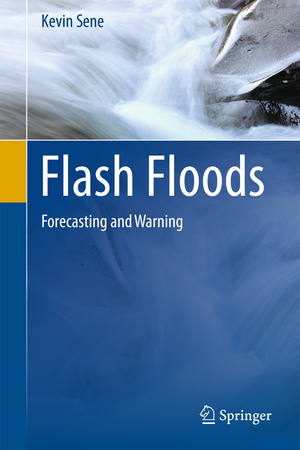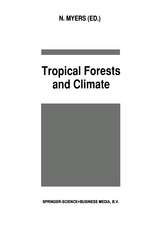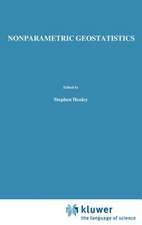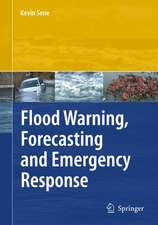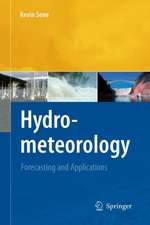Flash Floods: Forecasting and Warning
Autor Kevin Seneen Limba Engleză Hardback – 14 dec 2012
The book is potentially useful on civil engineering, water resources, meteorology and hydrology courses (and for post graduate studies) but is primarily intended as a review of the topic for a wider audience.
| Toate formatele și edițiile | Preț | Express |
|---|---|---|
| Paperback (1) | 1094.00 lei 6-8 săpt. | |
| SPRINGER NETHERLANDS – 29 ian 2015 | 1094.00 lei 6-8 săpt. | |
| Hardback (1) | 1105.93 lei 6-8 săpt. | |
| SPRINGER NETHERLANDS – 14 dec 2012 | 1105.93 lei 6-8 săpt. |
Preț: 1105.93 lei
Preț vechi: 1348.69 lei
-18% Nou
Puncte Express: 1659
Preț estimativ în valută:
211.75€ • 220.50$ • 175.69£
211.75€ • 220.50$ • 175.69£
Carte tipărită la comandă
Livrare economică 14-28 februarie
Preluare comenzi: 021 569.72.76
Specificații
ISBN-13: 9789400751637
ISBN-10: 940075163X
Pagini: 392
Ilustrații: XIV, 386 p.
Dimensiuni: 155 x 235 x 22 mm
Greutate: 0.91 kg
Ediția:2013
Editura: SPRINGER NETHERLANDS
Colecția Springer
Locul publicării:Dordrecht, Netherlands
ISBN-10: 940075163X
Pagini: 392
Ilustrații: XIV, 386 p.
Dimensiuni: 155 x 235 x 22 mm
Greutate: 0.91 kg
Ediția:2013
Editura: SPRINGER NETHERLANDS
Colecția Springer
Locul publicării:Dordrecht, Netherlands
Public țintă
ResearchCuprins
Introduction.-
-Causes of flash flooding.-
-Flood risk management.-
-Flash Flood Warning Systems.-
-Organisational Issues.-
-Technological Developments.-
-Summary.-
Precipitation measurement.-
-Introduction.-
-Raingauges.-
-Weather radar.-
-Satellite precipitation estimates.-
-Multi-sensor precipitation estimates.-
-Summary.-
Catchment monitoring.-
-Introduction.-
-River monitoring.-
-Catchment conditions.-
-Observation networks.-
-Summary.-
Rainfall forecasting.-
-Introduction.-
-Flash flood climatology.-
-Forecasting techniques.-
-Operational Considerations.-
-Summary.-
Flood forecasting.-
-Introduction.-
-Forecasting techniques.-
-Operational Considerations.-
-Summary.-
Flood warning.-
-Introduction.-
-Flood warning procedures.-
-Warning dissemination.-
-Warning messages.-
-Decision support systems.-
-Summary.-
Preparedness.-
-Introduction.-
-Flood risk assessment.-
-Flood response plans.-
-Post-event reviews.-
-Performance monitoring.-
-Emergency response exercises.-
-Improvement plans.-
-Summary.-
Rivers.-
-Introduction.-
-Flood risk assessments.-
-Warning systems.-
-Complicating factors.-
-Summary.-
Debris flows.-
-Introduction.-
-Debris flow risk assessments.-
-Warning systems.-
-Summary.-
Urban flooding.-
-Introduction.-
-Flood risk assessments.-
-Warning systems.-
-Summary.-
Dams and levees.-
-Introduction.-
-Flood risk assessments.-
-Warning systems.-
-Summary.-
Research.-
-Introduction.-
-Monitoring.-
-Forecasting.-
-Flood warning.-
-Summary.
-Causes of flash flooding.-
-Flood risk management.-
-Flash Flood Warning Systems.-
-Organisational Issues.-
-Technological Developments.-
-Summary.-
Precipitation measurement.-
-Introduction.-
-Raingauges.-
-Weather radar.-
-Satellite precipitation estimates.-
-Multi-sensor precipitation estimates.-
-Summary.-
Catchment monitoring.-
-Introduction.-
-River monitoring.-
-Catchment conditions.-
-Observation networks.-
-Summary.-
Rainfall forecasting.-
-Introduction.-
-Flash flood climatology.-
-Forecasting techniques.-
-Operational Considerations.-
-Summary.-
Flood forecasting.-
-Introduction.-
-Forecasting techniques.-
-Operational Considerations.-
-Summary.-
Flood warning.-
-Introduction.-
-Flood warning procedures.-
-Warning dissemination.-
-Warning messages.-
-Decision support systems.-
-Summary.-
Preparedness.-
-Introduction.-
-Flood risk assessment.-
-Flood response plans.-
-Post-event reviews.-
-Performance monitoring.-
-Emergency response exercises.-
-Improvement plans.-
-Summary.-
Rivers.-
-Introduction.-
-Flood risk assessments.-
-Warning systems.-
-Complicating factors.-
-Summary.-
Debris flows.-
-Introduction.-
-Debris flow risk assessments.-
-Warning systems.-
-Summary.-
Urban flooding.-
-Introduction.-
-Flood risk assessments.-
-Warning systems.-
-Summary.-
Dams and levees.-
-Introduction.-
-Flood risk assessments.-
-Warning systems.-
-Summary.-
Research.-
-Introduction.-
-Monitoring.-
-Forecasting.-
-Flood warning.-
-Summary.
Notă biografică
Kevin Sene is a civil engineer and researcher with wide experience in flood forecasting, water resources and hydrometeorological studies. He has published some 45 scientific and conference papers on topics in hydrology, hydrometeorology and hydraulics, and the books "Flood Warning, Forecasting and Emergency Response" (Springer, 2008) and "Hydrometeorology: Forecasting and Applications" (Springer, 2009)
Textul de pe ultima copertă
The book describes flash floods - one of the most devastating of natural hazards, which develop in a period of minutes to a few hours. Floods of this type are often characterised by fast flowing deep water and a high debris content which - combined with the short lead time available for warnings - add to the risk to people and property. The main cause of flash flooding is usually heavy rainfall; other causes can include the break- up of ice jams, dam breaches, and the failure of flood defenses and levees.
The volume discusses the increasing use of meteorological observation and forecasting techniques to extend the lead time available for warning, combined with hydrological models for the river response. It also presents probabilistic techniques and some current areas of research which include the use of weather radar and satellite data in improving meteorological forecasts, the development of improved forecasting and observation techniques for mountainous regions, and the use of distributed hydrological models specifically adapted for flash flood modelling.
This book reviews recent developments in this active research area, with a focus on events caused by heavy rainfall (including debris flows and landslides), but also considering other types of flash flooding, such as that caused by ice jams and dam and levee breaches. The topics covered include meteorological forecasting and monitoring techniques, rainfall-runoff and river modelling, approaches to issuing flood warnings, and some of the societal and behavioural aspects of providing an effective emergency response. A number of international examples of the application of these techniques are also provided.
The book is potentially useful on civil engineering, water resources, meteorology and hydrology courses (and for post graduate studies) but is primarily intended as a review of the topic for a wider audience.
The volume discusses the increasing use of meteorological observation and forecasting techniques to extend the lead time available for warning, combined with hydrological models for the river response. It also presents probabilistic techniques and some current areas of research which include the use of weather radar and satellite data in improving meteorological forecasts, the development of improved forecasting and observation techniques for mountainous regions, and the use of distributed hydrological models specifically adapted for flash flood modelling.
This book reviews recent developments in this active research area, with a focus on events caused by heavy rainfall (including debris flows and landslides), but also considering other types of flash flooding, such as that caused by ice jams and dam and levee breaches. The topics covered include meteorological forecasting and monitoring techniques, rainfall-runoff and river modelling, approaches to issuing flood warnings, and some of the societal and behavioural aspects of providing an effective emergency response. A number of international examples of the application of these techniques are also provided.
The book is potentially useful on civil engineering, water resources, meteorology and hydrology courses (and for post graduate studies) but is primarily intended as a review of the topic for a wider audience.
Caracteristici
The book covers recent developments in flash flooding from heavy rainfall, with a focus on forecasting and warning Considers such issues as assessing flash flood risk, and related types of flooding (e.g. debris flows, dam breach) Provides an international perspective, drawing on recent research and examples from Europe, the USA and elsewhere Treats the topic in an integrated way, discussing research findings from meteorology and hydrology, and some of the issues surrounding the provision of an effective response to flood warnings (e.g. evacuation of properties) Includes supplementary material: sn.pub/extras
